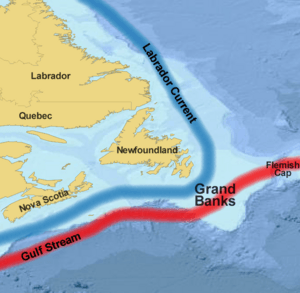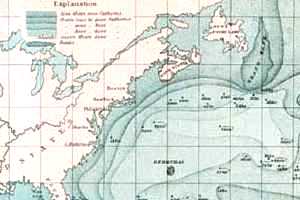Grand Banks of Newfoundland facts for kids
The Grand Banks of Newfoundland are huge underwater areas found southeast of Newfoundland, Canada. They are part of the North American continental shelf, which is the edge of a continent that is under the ocean. The Grand Banks are known as one of the best fishing spots in the world. Many different kinds of fish like Atlantic cod and swordfish live here. You can also find shellfish, many types of seabirds, and sea mammals like whales.
Contents
Why the Grand Banks Are Important
The Grand Banks of Newfoundland are a group of underwater flat areas, called plateaus, located southeast of Newfoundland. These areas are not very deep, usually between 15 and 90 meters (about 50 to 300 feet) deep.
A special thing happens here: the very cold Labrador Current from the north meets the warm Gulf Stream from the south. When these two currents mix, it often creates a lot of fog. This mixing also brings many nutrients from the deep ocean up to the surface. These nutrients are like food for tiny ocean plants, which then become food for small fish, and so on up the food chain.
Because of all these nutrients, the Grand Banks are home to a huge amount of sea life. You can find many kinds of fish like Atlantic cod, swordfish, haddock, and capelin. There are also shellfish like scallops and lobsters. Many seabirds, such as northern gannets and shearwaters, live here, along with sea mammals like seals, dolphins, and whales.
Sadly, in the late 1900s, too much fishing happened. This caused the number of some fish, especially cod, to drop a lot. Because of this, the Canadian government had to close the Grand Banks fishery in 1992 to help the fish populations recover.
History of the Grand Banks
Thousands of years ago, during the last ice age, a lot of ice covered the Grand Banks area. Around 13,000 years ago, most of this ice melted. This left the Grand Banks as several islands that stretched for hundreds of kilometers. But as sea levels rose, these islands became covered by water about 8,000 years ago.
Even though there isn't much old evidence, some people believe that sailors from the Basque Region and England might have visited the Grand Banks before John Cabot's famous trip in 1497. In the 1400s, some old writings mention a land called Bacalao, which means "land of the codfish." This might have been Newfoundland.
After Cabot's trip, Europeans quickly learned about the amazing fishing grounds on the Grand Banks. Ships from France and Portugal were the first to fish there, followed by ships from Spain. At first, not many English ships came, but this changed after 1585. Fishing on the Grand Banks became very important for the early European settlers in eastern Canada and New England.
On November 18, 1929, a big earthquake happened on the Grand Banks. This earthquake caused an underwater landslide that damaged many underwater telegraph cables. It also created a rare tsunami (a giant ocean wave) that hit the south coast of Newfoundland. This sad event caused 29 deaths.
Later, new fishing technologies, like large factory ships and sonar, made it easier to catch many more fish. Also, arguments between countries about who owned which parts of the ocean led to even more fishing. By 1990, the fish populations on the Grand Banks had seriously dropped. This led to Canada closing its Grand Banks fishery in 1993 to protect the fish.
Today, most of the Grand Banks are part of Canada's special fishing area, called an Exclusive Economic Zone (EEZ). However, some parts, like the "nose" and "tail" of the fishing area, are outside Canada's EEZ. The small French territory of Saint Pierre and Miquelon also has its own special fishing zone nearby.
Studying the Grand Banks
Canada is currently doing surveys to claim the entire continental shelf off its eastern coast. This is allowed under a special United Nations agreement called the United Nations Convention on the Law of the Sea (UNCLOS). If this claim is approved, Canada will control the remaining parts of the Grand Banks that are currently outside its EEZ.
Oil has also been found under the Grand Banks. Several oil fields, like Hibernia, Terra Nova, and White Rose, are being developed there. However, the ocean environment on the Grand Banks can be very rough. A sad accident happened here with an oil rig called the Ocean Ranger.
Climate Change Effects
The Grand Banks of Newfoundland are feeling the effects of human-caused climate change. The temperature of the surface water in this area has gone up by about 0.13 degrees Celsius every ten years between 1950 and 2016. This warming trend is important because it can affect the sea life that calls the Grand Banks home.
Grand Banks in Culture
The Grand Banks have appeared in many stories and films.
- In Rudyard Kipling's novel Captains Courageous (1897), you can read about fishermen working on the Grand Banks.
- Sebastian Junger's book The Perfect Storm (1997) is a non-fiction story that also features the Grand Banks.
- The 1990 film The Hunt for Red October also shows the Grand Banks.
- Herman Melville wrote about sailing through the Banks in his book Redburn: His First Voyage (1849).
- The book The Grey Seas Under by Canadian author Farley Mowat talks about a rescue tug boat working in the area.
See also
 In Spanish: Gran Banco de Terranova para niños
In Spanish: Gran Banco de Terranova para niños



